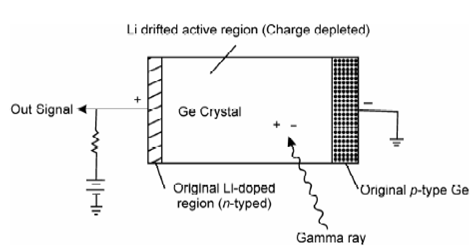Semiconductor Detector
These detectors work on the same principle as a gas-ionization detector except that instead of a filler gas a solid semiconductor crystal is used. It consists of primarily a semiconductor material such as Si or Ge block in which a group III A element such as Ga is incorporated as imparity. This is called a p-type semiconductor because of positive holes available for conduction. On the contrary if a group V element such as P is introduced into Ge, it will become an n-type semiconductor as it contains negative sites available for conduction. An n-type semiconductor has a higher density of free electrons than pure semiconductor whereas p-type semiconductor has lower density of free electrons as shown in Figure. Another requirement for a solid state ionization detector is an element such as Li whose atoms are small enough to fit into the interstitial sites of Ge. Thus, a Ge crystal with Li diffused into it, called Ge (Li) detector, proves to be most satisfactory for higher resolution of gamma rays.

Figure: Schematic of a typical semiconductor Ge (Li) detector